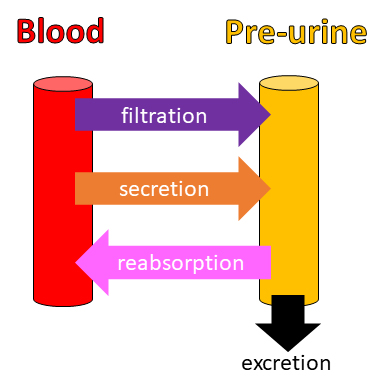
The function of the kidneys is to help maintain a constant internal environment (homeostasis) by regulating the volume and chemical composition of the blood. This regulation occurs via three fundamental processes: filtration, secretion, and reabsorption. Because these three processes all concern transfers between the blood and the pre-urine, inexperienced biology students frequently confuse them with each other and with the related process of excretion. Such confusion impairs understanding of the kidney’s regulatory functions. For instance, the effects of H+ secretion and HCO3- reabsorption on plasma pH can only be predicted if one knows that secretion entails removal from the blood while reabsorption entails addition to the blood. The enclosed three-part lesson teaches these processes through the use of multiple related examples with clinical relevance. In Module A (“Simple Math”), students define the direction of transfer (blood to pre-urine or pre-urine to blood) for each process, create a simple equation to show how excretion rate depends on these three processes, and solve the equation for missing values. In Module B (“Simple Graphs”), students show qualitatively how the three processes affect the composition of the pre-urine and (by implication) the blood. In Module C (“GFR”), students examine the relationship between glomerular filtration rate (GFR) and plasma levels of solutes like creatinine. By presenting multiple related examples embedded in the framework of Test Question Templates (TQTs), this lesson promotes a solid understanding of filtration, secretion, reabsorption, and excretion that can be applied to any naturally occurring substance or drug.
Primary image: Four urinary system processes. This image visually summarizes the four processes covered in this lesson: filtration, secretion, reabsorption, and excretion.